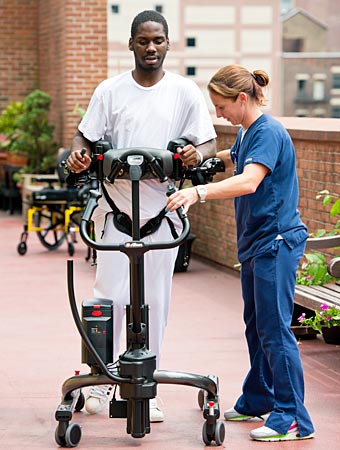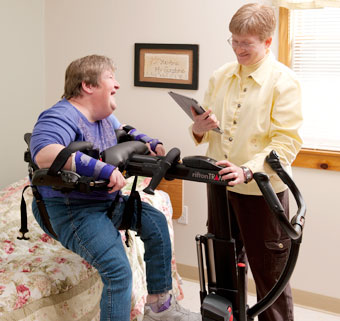
Why Worry about Lifting?
In the healthcare setting, manually lifting or transferring patients causes musculoskeletal injury for both staff and patients. As a result, many healthcare facilities have implemented “no-lift” or “zero-lift” safe patient handling (SPH) policies requiring the use of mechanical lifts for all patient transfer and positioning tasks. The results have been dramatic. Study after study across the healthcare sector shows a dramatic decrease in staff and caregiver injuries and a reduction in workers compensation costs when such devices are used.
Sling-Lift Woes
Despite the obvious benefits of safe patient handling, adhering to no-lift guidelines can be difficult for staff and caregivers. More often than not it has to do with the lack of adequate equipment and training to meet the needs of the patient and the task. Difficulties arise when equipment is large, cumbersome and complicated, requiring extra room and extending the time to perform a transfer. With the Hoyer® and other sling-type lifts, patients complain of feeling insecure, and staff complain that positioning the sling underneath the patient is too strenuous. In the words of a patient: “As I have gained some weight in recent years, lifting, transferring and carrying me has become more difficult. I tried traditional sling lifts. Unfortunately, they all pushed my back brace up into my throat almost choking me during transfers. I also tended to slowly slip through the slings making me feel extremely unsafe and at risk of falling.” Too often we see patients and staff avoiding their Hoyer® lift when mechanical assistance could make an enormous difference.
Solving the SPH Trifecta
Enter the Rifton TRAM. A device that solves most of these lift and transfer woes, the TRAM is popular in a broad range of clinical settings among staff, caregivers and patients. This compact, ultralight device tackles the three primary patient handling tasks: the seated transfer, sit-to-stand lifting, and gait training—call it the SPH trifecta. These three functions delivered with one device, combined with the low profile and ultralight engineering of the TRAM, place it far above the competition. Consider these advantages as well:
TRAM Economics

The TRAM’s simple design and ease of use improve safe patient handling compliance, which always saves money. Sarah Ming, CST at Elk Grove Adult Community Training in California confirms this. “We have purchased five Rifton TRAMs that are being used at our three program sites. Now for the first time we can say we are a “no lift” program. We have about 65 employees serving 150 clients with a wide variety of physical disabilities, but we have not had a single injury since we started using the TRAM, and we have lowered our mod rate from 235 to 150 which has saved our company almost $100,000 this year in workers’ comp premiums.”
The TRAM’s versatility also saves money (and space). By combining three essential functions in one device, the TRAM effectively eliminates two separate pieces of equipment in the standard SPH arsenal.
And finally yet most importantly, using the TRAM benefits the patient. With the opportunity for secure and supported weight-bearing, patients maintain function and progress in their rehabilitation. For example, PT Laura Laskey notes that in the home health setting, previously bed-ridden patients using a Hoyer® for all transfers could, with the help of the TRAM, perform a stand-pivot transfer. This improved their functional level and quality of life to such a degree that they could ultimately remain in their homes longer before requiring institutionalized care.
Summing up the benefits of the Rifton TRAM, Charles Schramm, a consulting therapist for the residence division at Center for Disabilities Services in Albany, New York, says it best: “I compare the Rifton TRAM to David versus the Goliath of the Hoyer®-style lifts that predominate in my field. It’s the new entrant that has surprised us all by its simple, sleek design that far out-performs the cumbersome sling lifts. And while it’s great for the seated transfer, the true benefit of the TRAM is its ability to deliver safe, secure gait training. Our staff and consumers feel confident with the TRAM and no longer worry about sustaining work-related injuries. I’m confident this lift will reduce worker’s comp claims in our facility. Finally, I love the TRAM’s superior maneuverability and great pricing. We’re saving money, saving backs, and delivering great care to our consumers—a conquering David!”